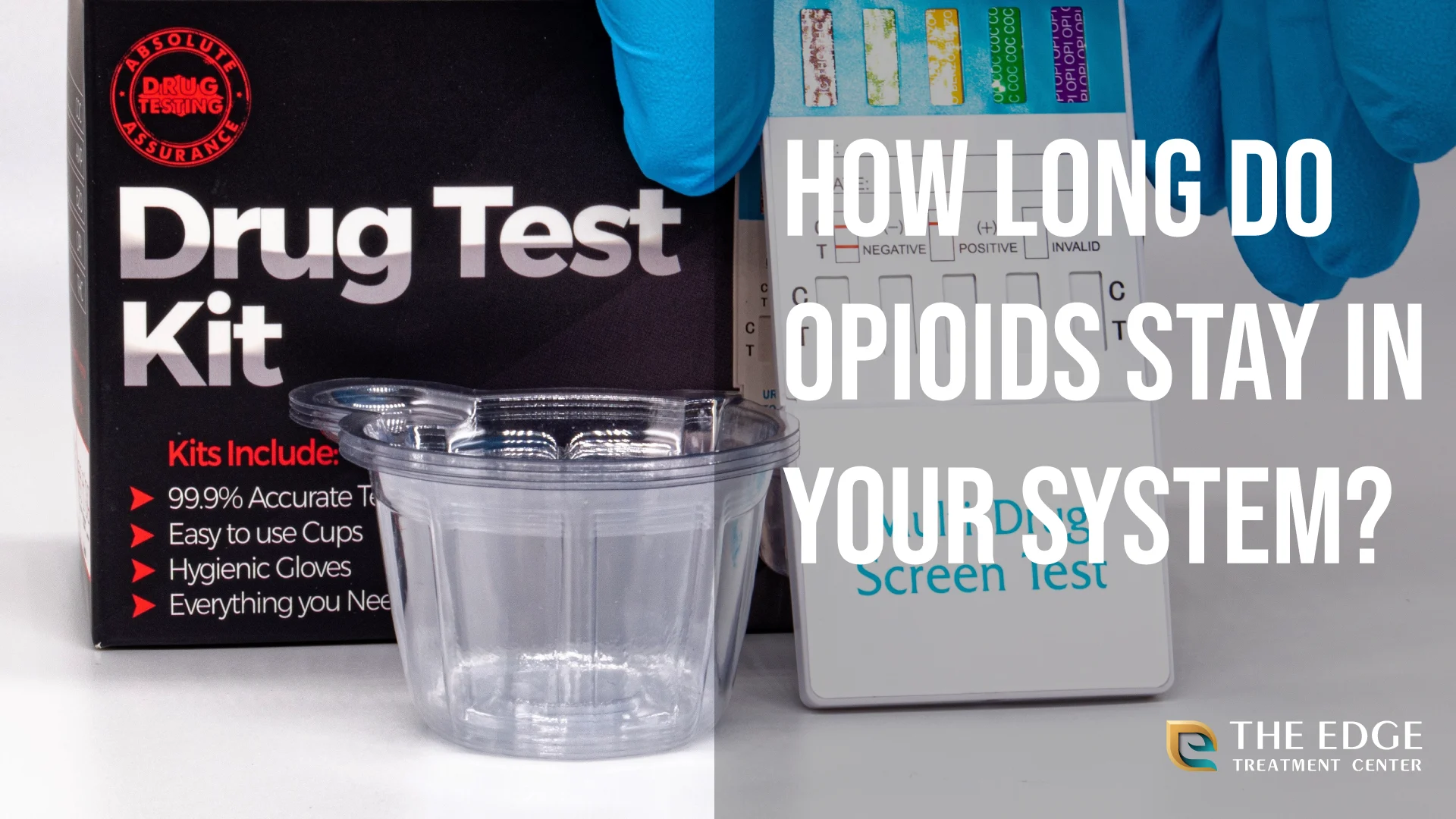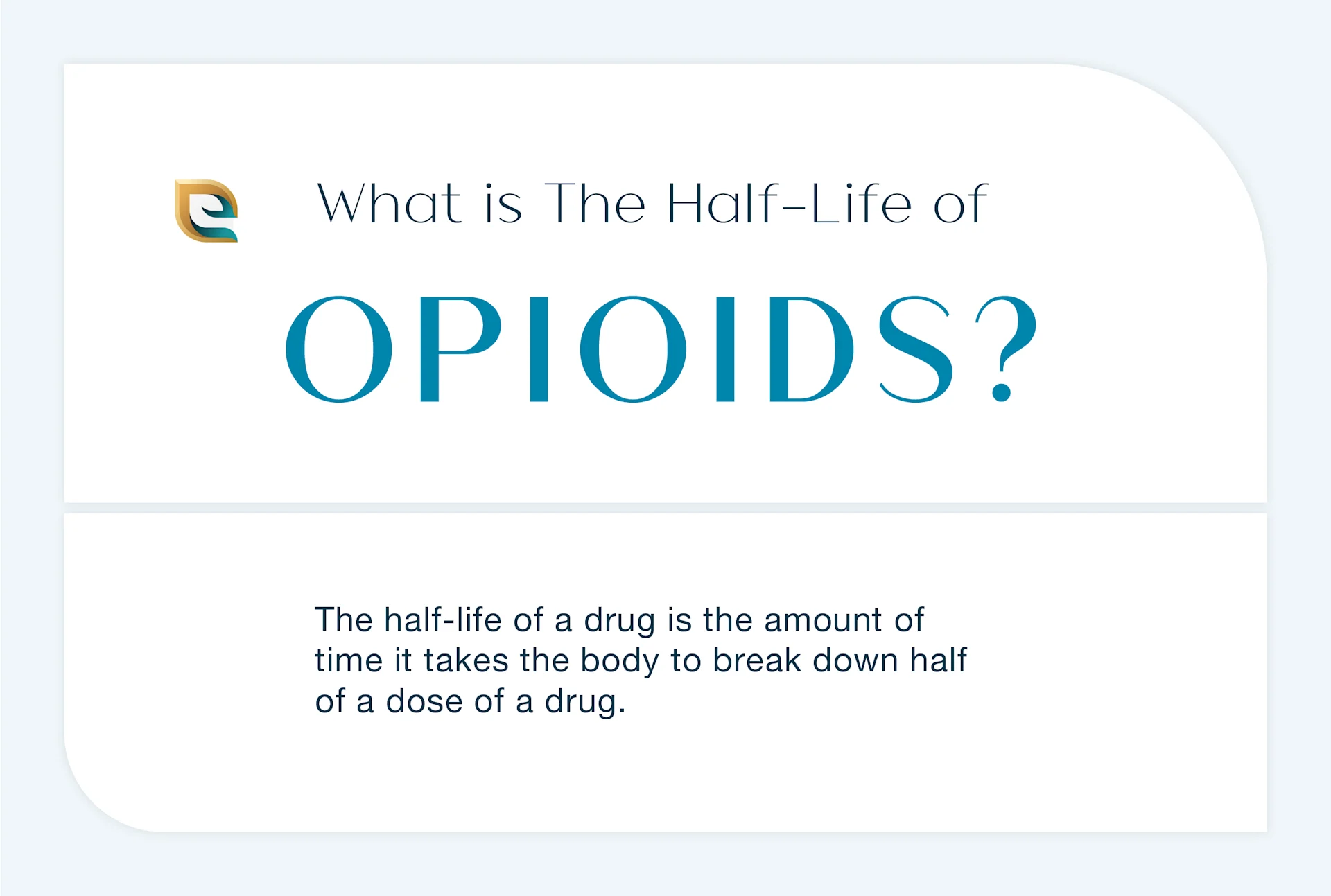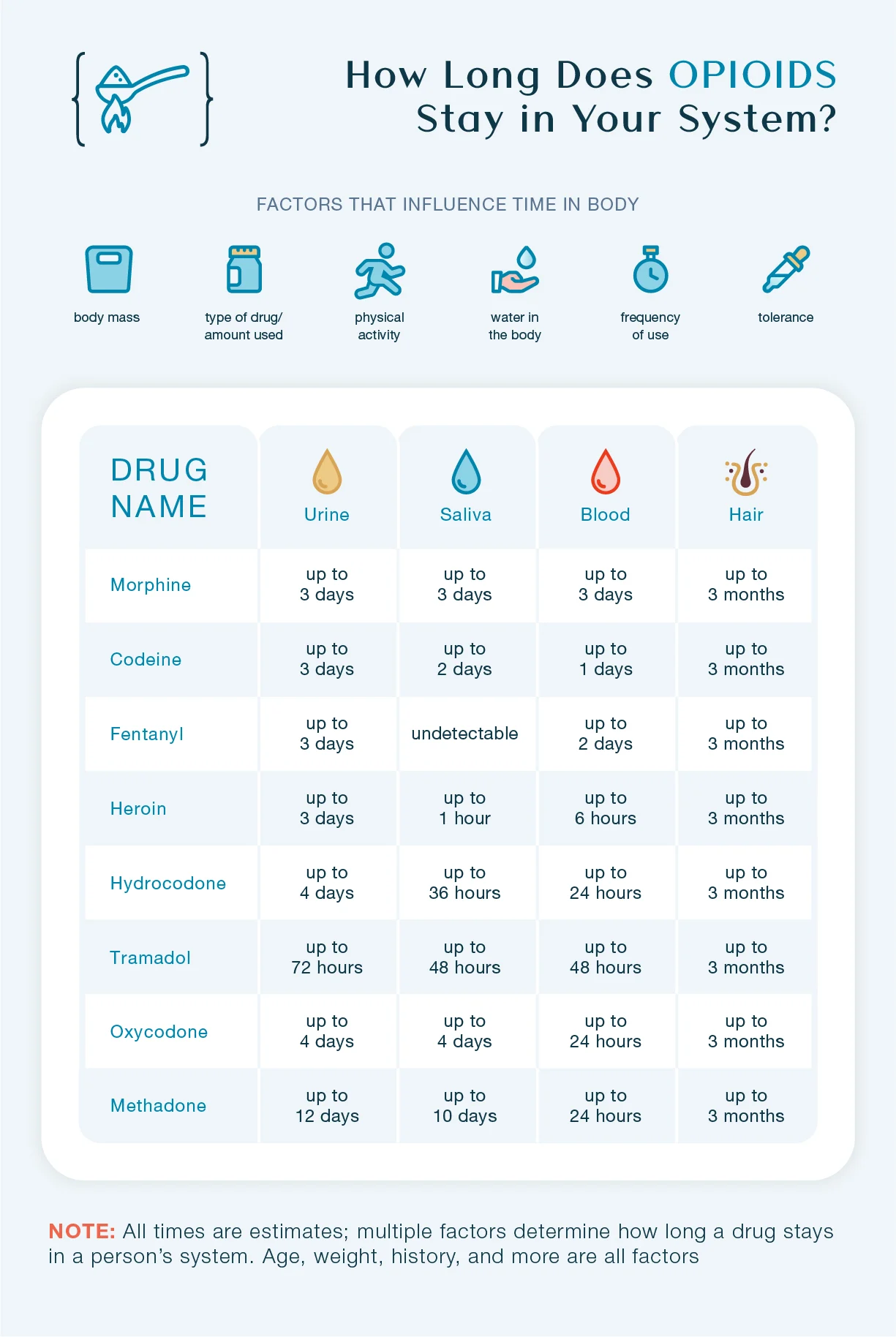Drug and Alcohol - Opioid Addiction
How Long Do Opioids Stay in Your System?

How long do opioids stay in your system? There's surprising differences between opioid drugs. Opioid abuse is often deadly. Learn more in our blog.
Natural opiates and synthetic opioids are indeed fueling a wave of addiction in the US. Opioids represent the most notorious type of substance abuse in the nation with policymakers and healthcare bodies often referring to the problem as an opioid epidemic. This is largely due to the nationwide availability of prescription medications that contain an opioid formulation and illegal practices that provide easy access to opioids.
This discussion will put the spotlight on drug testing methods and how the duration for which a drug stays in the body becomes a critical aspect of such clinical procedures.
By the Numbers:
48,006 people overdosed on opioids in 2020. Prescription opioid abuse costs $78.5 billion annually in the form of healthcare, legal programs, and lost productivity - NCDAS
Opioids are a factor in at least 7 out of every 10 overdose deaths. Prescription opioids are a factor in 32% of opioid overdose deaths. Doctors write enough opioid prescriptions for 46.7% of Americans to receive one - NCDAS
Drug Tests & Opioids: How Long Do Opioids Stay in Your System?
Drug testing may be necessary for a variety of reasons, including:
Court-ordered testing
Probation-related procedures
Legal cases that need drug profiling
Divorce arguments and settlements where drug abuse needs to be proven
Employee testing in many organizations that maintain a strict no-drug policy
In addition, many sports officials conduct urine drug tests to determine if athletes have used performance-enhancing drugs. There are different types of drug tests available that depend on the objective for carrying out a drug test. These tests include collecting samples of urine, saliva, hair, or blood.
Urine testing is the most prevalent because it is easy, inexpensive, and delivers results a lot quicker than other methods. It is also the only testing method that has got the nod as a part of the federal testing standards. Urine testing can detect if a substance has been used in the past few days for most drugs.
Hair drug testing is highly effective and almost impossible to cheat, as the hair follicle from the individual's head is taken and sent to a laboratory for analysis. It can reveal if someone has used most drugs for a much longer period, sometimes up to 90 days in the past. Hair testing is also the most efficient method to detect ongoing or repetitive drug use because if a person only used a drug once, they are less likely to test positive. Hair tests are also effective in producing comparative test results to determine when a drug was used, how long it was used, or if the drug use was recently discontinued.
However, it is not ideal for drug-testing officials who only want short-term results. It also has a longer turnaround time and it can be slightly more expensive.
Understand Opioids: What Are Opioids?
Opioids are a class of drugs commonly prescribed for alleviating different types of pain. They are also referred to as prescription medications with a high risk of addiction or dependence. They work by attaching to specific receptors in the brain and spinal cord, reducing the human body’s perception of pain. Opioids can produce feelings of euphoria and relaxation, which can lead to their misuse and addiction. What starts with a feeling of relief can quickly turn into a type of high that the user seeks repeatedly to feel better.
Examples of common opioids include prescription painkillers such as oxycodone and fentanyl and illegal drugs such as heroin. Opioids can be taken orally, injected, or inhaled, and each method of administration can affect how long the substance will stay in the system.
First developed in 1959-60, fentanyl is 50 to 300 times more potent than morphine. Valued as a “miracle drug” by pain specialists, skyrocketing overdose rates have made for more conservative usage - NCDAS
Is There a Difference Between Opioids and Opiates?
Technically, yes. Opiates are natural derivatives of the opioid plant. Morphine and codeine are both opiates. Opioids, on the other hand, are synthetic opiates. Heroin, oxycodone, fentanyl, and hydrocodone are just a few of the many synthetic and semisynthetic opioids.
The terms are used interchangeably these days; opiate is something of an old-fashioned word, too. In general, most people us the word opioid.

We’re Here To Help You Find Your Way
Would you like more information about how long opioids stay in your system? Reach out today.
An Overview of How Opioids Affect the Body
When opioids bind to the opioid receptors in the brain, they trigger a release of dopamine. This biochemical is responsible for bringing about feelings of euphoria and pleasure and when dopamine levels are elevated, the person is bound to feel better. This can create a false sense of reward that can lead to opioid abuse.
Prolonged use of opioids can lead to opioid addiction, which means that the body has adapted to the presence of the drug and requires it to function normally. When an individual stops using opioids, they may experience withdrawal symptoms, such as nausea, vomiting, muscle aches, and unexplained anxiety.
What Are the More Common Symptoms of an Opioid Overdose?
Every year, thousands of Americans are rushed to hospitals on account of an opioid overdose. If not handled by a trained clinician, the overdose can quickly turn lethal. This also underlines the level of toxicity opioids create and why knowing the half-life of opioids and the duration for which they are expected to be retained in the body is important.
Signs of an opioid overdose include the following:
Slow, shallow breathing
Sleepiness or drowsiness
Blue-colored skin or the skin turning pale
Dark-colored lips
Gurgling sounds from the mouth
Inability to speak properly, slurred speech


We’ll Lead You to New Heights
Do you have more questions about how long opioids stay in your system? Reach out.
Factors that Affect How Long Opioids Stay in the System
Individuals with faster metabolism tend to eliminate opioids from their bodies more quickly than those with a slower metabolism. People who exercise more or tend to have a more active lifestyle might expel the drug a lot faster. This is because the body’s metabolism plays a crucial role in breaking down prescription drugs or abused drugs and eliminating them from the body. There are many other factors that can influence how long opioids can stay in the system, including:
Type of drug(s) used
The presence of other drugs or alcohol
Ethnicity [genetic predisposition]
Gender
Weight
A drug’s half-life
Metabolic rate
Medical conditions that affect drug elimination processes
Physical activity
Drug tolerance
Amount of drug(s) used
Frequency of use
Hydration levels
Body mass index [BMI]
Short-Acting Opioids & Long-Acting Opioids
Short-acting opioids include morphine, codeine, and hydrocodone and these substances tend to be expelled a bit faster. Examples of longer-acting opioids include methadone and fentanyl and these opioids can stay in the body for an extended period of up to 10 days or even more. It is essential to understand that a drug's half-life affects the duration for which it stays in the system. The half-life of a drug is the time it takes for the body to eliminate nearly half of the substance.
For example, the half-life of codeine is around four hours, which means that it can take up to 16 hours for this substance to be eliminated from the body. On the other hand, the half-life of morphine is just about 2 to 4 hours, and it can take up to 24 hours to be entirely eliminated from the body. The metabolites of longer-acting opioids tend to stay in the system for much longer. Some metabolites or byproducts of the substance being broken down in the body can be detected for up to several days or weeks after using the drug.
Hydration and Urine pH Levels Have a Pronounced Effect
Hydration levels and urine pH levels can also affect how long opioids stay in the system. Individuals who are well-hydrated tend to eliminate drugs from their bodies more quickly than those who are dehydrated. Someone who is using a lot of fluids due to exercising heavily might eliminate the drug a lot faster. Additionally, urine pH levels can also influence the rate of drug elimination in a person. Alkaline urine pH levels can help eliminate drugs faster, while acidic urine pH levels might prolong the drug’s stay in the body.

We’re Here To Help You Find Your Way
Do you need advice about how long opioids stay in your system? Reach out today.
Opioid Drug: Morphine
Morphine is a powerful pain reliever and one of the most abundant opiates found in opium. This analgesic substance is utilized in many forms of clinical pain management, including relief for terminal cancer patients and as a part of postoperative pain management. However, it is also frequently used recreationally by drug users, leading to addiction and severe dependence. Morphine provides many sought-after or clinically warranted effects, including suppressing acute cough or reducing pain but due to its well-established euphoric effects, this opioid is illegally used by drug dealers.

Some data about how long an opioid stays in the system based on the common drug detection testing standards:
Blood Test
Morphine is detectable for up to 3 days in blood.
Saliva Test
Morphine is detectable for up to 3 days in saliva.
Urine Test
Morphine is detectable for up to 3 days in urine.
Hair Tests
Morphine is detectable for up to 90 days in hair.
Opioid Drug: Codeine
Codeine is a commonly used narcotic medication for managing mild-to-moderate levels of pain, cough, and gastrointestinal issues. It belongs to the opiate class of drugs and is derived from the opium poppy plant. While most people take it as prescribed without any issues, some individuals may develop an addiction to the drug.
Historically, opioids like codeine have been used to manage chronic pain in patients. However, they have now become the drug of choice for many drug addicts around the world. Opiates such as codeine have powerful effects on the user, including quick pain relief and a pleasurable euphoric sensation at higher doses.
When opioids enter the central nervous system, they stimulate the release of hormones associated with feelings of pleasure. It is this feeling that codeine addicts seek and crave.
Some data about how long an opioid stays in the system based on the common drug detection testing standards:
Urine Test
Codeine is detectable for up to 3 days in urine.
Hair Test
Codeine is detectable for up to 90 days in hair follicle samples.
Blood Test
Codeine can be detected in the blood for up to 24 hours.
Saliva Test
Codeine is detectable in saliva for up to two days.

We’ll Lead You to New Heights
Would you like more information about how long opioids stay in your system? Reach out today.
Opioid Drug: Fentanyl
Individuals who struggle with substance use disorders can obtain fentanyl through various means, such as procuring it illegally from medical supplies or manufacturing it in illegal laboratories. The drug can be consumed through oral ingestion, smoking, snorting, or injection, and no method of use is inherently safer than another. Even discarded fentanyl patches may contain substantial amounts of the drug, which individuals with opioid use disorders may remove and consume through various means, including placing it under the tongue or injecting it.
Compared to heroin, many fentanyl analogs are much more potent, which makes them even more dangerous. Drug dealers may mix fentanyl with other illegal drugs, such as heroin or cocaine, without informing the user, thereby increasing the risk of accidental overdose or death.
Some data about how long an opioid stays in the system based on the common drug detection testing standards:
Urine Test
Fentanyl can be detected in urine drug tests for up to 3 days.
Hair Test
A hair drug test can detect fentanyl for up to 90 days.
Blood Test
Blood drug tests can detect fentanyl for up to 2 days.
Other Common Opioids
Here's how long other common opioids can be detected in the system via drug testing:
Heroin
Blood test: Up to 6 hours
Saliva test: Up to 1 hour
Urine test: Up to 3 days
Hair test: Up to 90 days
Hydrocodone
Blood test: Up to 24 hours
Saliva test: Up to 36 hours
Urine test: Up to 4 days
Hair test: Up to 90 days
Tramadol
Blood test: Up to 48 hours
Saliva test: Up to 48 hours
Urine test: Up to 72 hours
Hair test: Up to 90 days
Oxycodone
Blood test: Up to 24 hours
Saliva test: Up to 4 days
Urine test: Up to 4 days
Hair test: Up to 90 days
Methadone
Blood test: Up to 24 hours
Saliva test: Up to 10 days
Urine test: Up to 12 days
Hair test: Up to 90 days
What Are the More Common Opioid Withdrawal Symptoms?
Opioid withdrawal management is one of the most debated topics in addiction medicine because the symptoms of opioid withdrawal can be extreme and many. Symptoms can include all or some of the following:
Diarrhea
Tremors (shaking)
Feeling cold
Anxiety/irritability
Insomnia
Abdominal pain
Vomiting (nausea)
The More Common Causes of Opioid Abuse
There are several factors that have contributed to the rise of opioid abuse in the US, and overprescription is a big reason. The widespread availability of opioids has led to more and more healthcare settings putting up prescriptions for opioid medications, which can lead to physical and psychological dependence and severe addiction in the long term.
Secondly, most people seem unaware of the risks associated with opioid use, including the potential for addiction if used without clinical supervision. Few people understand the need to keep away such highly abused medications away from children or from someone in the family who seems attracted to exploring recreational drugs. Also, not many people realize the fine line differentiating pain relief from developing pain-relief addiction.
How to Prevent Opioid Abuse
Preventing opioid abuse begins with being more aware of the problem and spreading the right information about prescription medication abuse. It is crucial to understand the dangers of opioid abuse and the first signs of opioid addiction. If you have been prescribed opioids, take them as directed by your physician, never adjusting the dosage yourself. It is also essential to store opioids in a secure location to prevent others from accessing them.
If you or a loved one are struggling with opioid abuse, seek help immediately. Treatment options include medication-assisted treatment, therapy, and support groups but you need to find a nearby drug rehab program that suits your rehab preferences or recovery goals.
If You or Someone You Know Is Addicted to Opioids, Reach Out to The Edge Treatment Center Today
Ultimately, opioids can stay in the system long enough to kill. The Edge Treatment Center provides expert care for opioid addiction and more. Don't risk an opioid overdose! Contact The Edge Treatment Center today to learn more about our opioid addiction treatment program and more.

We’re Here To Help You Find Your Way
If you or a loved one is struggling with addiction, there is hope. Our team can guide you on your journey to recovery. Call us today.
Written by
 Brian Moore
Brian MooreContent Writer
Reviewed by
 Jeremy Arzt
Jeremy ArztChief Clinical Officer
Drug and Alcohol
Opioid Addiction
February 10, 2025
